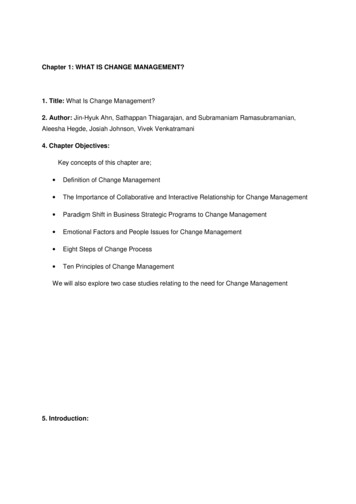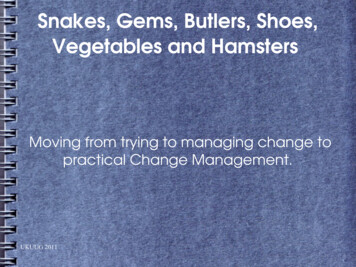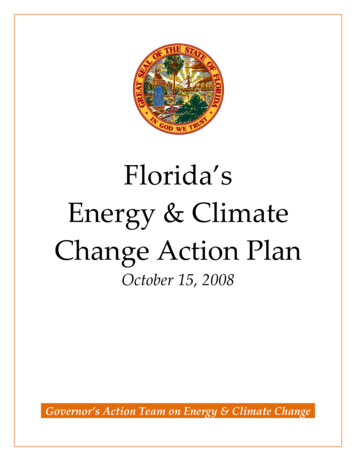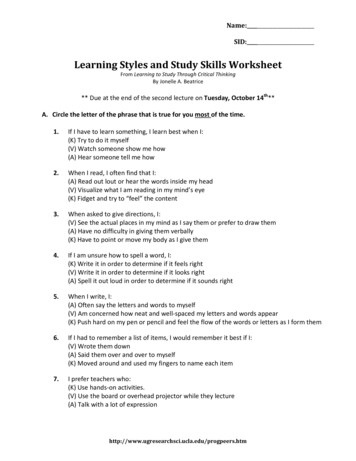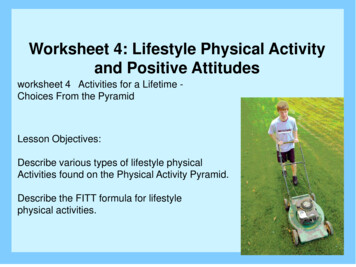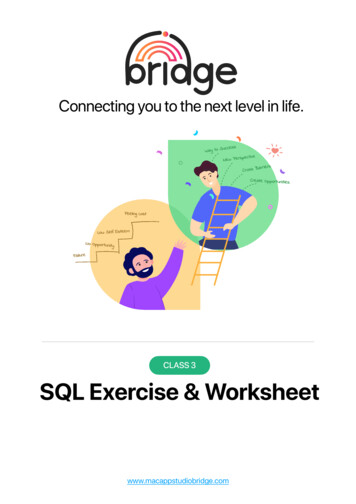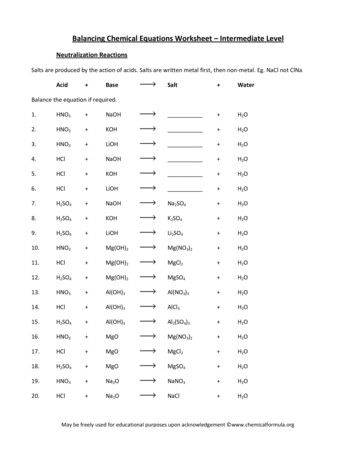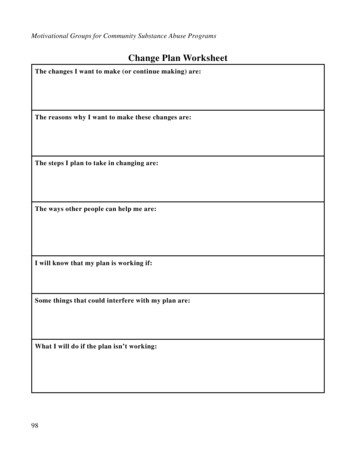
Transcription
Motivational Groups for Community Substance Abuse ProgramsChange Plan WorksheetThe changes I want to make (or continue making) are:The reasons why I want to make these changes are:The steps I plan to take in changing are:The ways other people can help me are:I will know that my plan is working if:Some things that could interfere with my plan are:What I will do if the plan isn’t working:98
Part Three: GroupsChange Plan Worksheet OutlineThe changes I want to make are:List specific areas or ways in which you want to changeInclude positive goals (beginning, increasing, improving behavior)The most important reasons why I want to make these changes are:What are some likely consequences of action and inaction?Which motivations for change seem most important to you?The steps I plan to take in changing are:How do you plan to achieve the goals?Within the general plan, what are some specific first steps you might take?When, where and how will these steps be taken?The ways other people can help me are:List specific ways that others can help support you in your change attemptHow will you go about eliciting others’ support?I will know that my plan is working if:What do you hope will happen as a result of the change?What benefits can you expect from the change?Some things that could interfere with my plan are:Anticipate situations or changes that could undermine the plan.What could go wrong?How might you stick with the plan despite the changes or setbacks99
Motivational Groups for Community Substance Abuse ProgramsChange Plan Worksheet ExampleThe changes I want to make are:1. Stop smoking crack2. Reduce my drinking3. Take better care of my kidsThe most important reasons why I want to make these changes are:1. Get out of trouble with probation–avoid dirty urines2. Take better care of my health3. Give my kids a better chance.The steps I plan to take in changing are:1.2.3.4.5.6.7.8.Keep coming to group and treatment here.Give urines to my P.O. every week.Spend time each day focusing on my childrenGo to my kids’ schools to meet their teachers.Stop using crack, one day at a time.Get a sponsor at NA.Avoid hanging out with people who use.Go back to church.The ways other people can help me are:1.2.3.4.5.My P.O. can encourage me when I give a clean urine.My counselor can help me deal with my depression.My group can help me talk about my difficulties in quitting.My mom can care for my kids when I’m working or at treatment.My sponsor can help me when I have a craving.I will know that my plan is working if:1.2.3.4.5.I am not using crack.I am giving clean urines.I am coming to group 8 out of 10 times.I am spending time each day focusing on my children and their needs.I am going to NA 3 times a week.Some things that could interfere with my plan are:1.2.3.4.If I get sent back to jail for a dirty urine.If I don’t plan ahead for cravings and urgesIf I don’t stop hanging with using friends.If I quit treatment.What I will do if the plan isn’t working:1.2.3.4.Be honest with my counselor and my group and ask for help.Make another plan that takes care of cravings/urges better.Tell my P.O. I need residential treatment or more treatment.Refuse to let myself feel like a failure100
Responding to Change Talk: EARS!Elaborating:In what way ?; Tell me more ;What else?Affirming:That took a lot of courage; You’re aperson who can make changes whenyou need to Reflecting:That’s really important to you ;You realize it’s become a problem Summarizing:There are a number of things I’mhearing about your situation . First,you’re concerned about . Also,you feel , and you are thinking Responding to Change Talk: EARS!Elaborating:In what way ?; Tell me more ;What else?Affirming:That took a lot of courage; You’re aperson who can make changes whenyou need to Reflecting:That’s really important to you ;You realize it’s become a problem Summarizing:There are a number of things I’mhearing about your situation . First,you’re concerned about . Also,you feel , and you are thinking
EvocativeQuestionDecisionalBalance(Assumes client has aconcern, idea, or resource)(Looking at both sidesof the ambivalence)Ask for anExampleQuery ExtremesAsk forElaborationImportance/Confidence RulerLookingBackLookingForward(Worst thing ? Best thing ?)ExploreGoals/Values(What’s important to you?)Come Alongside(Side with the status quo)
EvocativeQuestionDecisionalBalance(Assumes client has aconcern, idea, or resource)(Looking at both sidesof the ambivalence)Ask for anExampleQuery ExtremesAsk forElaborationImportance/Confidence RulerLookingBackLookingForward(Worst thing ? Best thing ?)ExploreGoals/Values(What’s important to you?)Come Alongside(Side with the status quo)
EvocativeQuestionDecisionalBalance(Assumes client has aconcern, idea, or resource)(Looking at both sidesof the ambivalence)Ask for anExampleQuery ExtremesAsk forElaborationImportance/Confidence RulerLookingBackLookingForward(Worst thing ? Best thing ?)ExploreGoals/Values(What’s important to you?)Come Alongside(Side with the status quo)
EvocativeQuestionDecisionalBalance(Assumes client has aconcern, idea, or resource)(Looking at both sidesof the ambivalence)Ask for anExampleQuery ExtremesAsk forElaborationImportance/Confidence RulerLookingBackLookingForward(Worst thing ? Best thing ?)ExploreGoals/Values(What’s important to you?)Come Alongside(Side with the status quo)
EvocativeQuestionDecisionalBalance(Assumes client has aconcern, idea, or resource)(Looking at both sidesof the ambivalence)Ask for anExampleQuery ExtremesAsk forElaborationImportance/Confidence RulerLookingBackLookingForward(Worst thing ? Best thing ?)ExploreGoals/Values(What’s important to you?)Come Alongside(Side with the status quo)
EvocativeQuestionDecisionalBalance(Assumes client has aconcern, idea, or resource)(Looking at both sidesof the ambivalence)Ask for anExampleQuery ExtremesAsk forElaborationImportance/Confidence RulerLookingBackLookingForward(Worst thing ? Best thing ?)ExploreGoals/Values(What’s important to you?)Come Alongside(Side with the status quo)
EvocativeQuestion(Assumes client has aconcern, idea, or resource)DecisionalBalance(Looking at both sidesof the ambivalence)Ask for anExampleQuery ExtremesAsk forElaborationImportance/Confidence RulerLookingBackLookingForward(Worst thing ? Best thing ?)ExploreGoals/Values(What’s important to you?)Come Alongside(Side with the status quo)
EvocativeQuestionDecisionalBalance(Assumes client has aconcern, idea, or resource)(Looking at both sidesof the ambivalence)Ask for anExampleQuery ExtremesAsk forElaborationImportance/Confidence RulerLookingBackLookingForward(Worst thing ? Best thing ?)ExploreGoals/Values(What’s important to you?)Come Alongside(Side with the status quo)
EvocativeQuestion(Assumes client has aconcern, idea, or resource)DecisionalBalance(Looking at both sidesof the ambivalence)Ask for anExampleQuery ExtremesAsk forElaborationImportance/Confidence RulerLookingBackLookingForward(Worst thing ? Best thing ?)ExploreGoals/Values(What’s important to you?)Come Alongside(Side with the status quo)
EvocativeQuestion(Assumes client has aconcern, idea, or resource)DecisionalBalance(Looking at both sidesof the ambivalence)Ask for anExampleQuery ExtremesAsk forElaborationImportance/Confidence RulerLookingBackLookingForward(Worst thing ? Best thing ?)ExploreGoals/Values(What’s important to you?)Come Alongside(Side with the status quo)
Motivational Interviewingfor OAPP GranteesTrainer: Tim Hunt, LCSW (PhD candidate)Dir., Training and CapacityBuilding, Social InterventionGroup, Columbia Univ. School ofSocial Work; Behavioral ScientistOffice of Adolescent PregnancyPrevention (OAPP)February 9-10th, 2010, Grand Hyatt
Training GoalTo increase participants’ knowledgeand skill related to MotivationalInterviewing to enhance healthoutcomes for pregnant andparenting adolescents and theirfamilies.
Training Objectives{By the end of this workshops,participants will:zzzReview the key concepts and principlesof Motivational Interviewing (MI)Enhance skill in utilizing MI spirit andtechniques to improve health behaviorchange in the clients being servedDescribe steps to integration of MI intocurrent programs, including supervisionand coaching to assist others inimplementation.
Day I{{{IntroductionsFind someone who has an answer on your cross wordpuzzlez Introduce yourself and your programMove onto the next person until you have completed yourcrossword.Once your cross word is completed, pair up with the lastperson you encountered to discuss (or when trainer callstime):How long have you been working with teens?How long have you been using MI?What component of MI do you feel you do particularlywell?What would you like to improve in your use of MI?Write your answers on an index card at the table withno names.
Eight Stages in Learning MI1.The SPIRIT of MI2.OARS – client-centered counseling skills3.Recognizing and reinforcing change talk4.Eliciting and strengthening change talk5.Rolling with Resistance6.Developing a Change Plan7.Consolidating client commitment8.Shifting flexibly between MI and othermethods Miller & Moyers, 2006
“MI is like scout training. To get out ofthe woods, you must look 1 tree aheadat a time, moving to that tree, & repeatagain, and again Our job is to help clients talkthemselves out of the woods.”---Bill Miller, 2007
Overview of MI
What Motivates People and Howdo People Change Behavior?
Motivation
Self Determination Theory{{{A general theory of human motivationconcerned with the development andfunctioning of personality within socialcontextsFocuses on the degree to which humanbehaviors are volitional or selfdeterminedThree primary motivators:zzzautonomycompetence feedbackrelatednessDeci, Edward L.; & Ryan, Richard M. (1985). Intrinsic motivationand self-determination in human behavior. New York: Plenum.
Maslow’s Hierarchy of NeedA.H. Maslov, A Theory of Human Motivation, Psychological Review 50 (1943):370-96
Stages of Change or the TranstheoreticalModel of Behavior Change (TTM)Prochaska, DiClemente & NorcrossoDEFINES “MOTIVATION” ASTHE “PROBABILITY” THAT APERSON WILL ENTER INTO, CONTINUE, AND ADHERE TOA SPECIFIC CHANGE ityo ANTICIPATED BENEFITSs SOCIAL NORMSo SKILLS
Stages of ChangeProchaska, DiClemente & NorcrossDeterminationDecision
Stages of Change (SOC)James Prochaska, PhD., and Carlo DiClemente, PhD.identified stages that people progress through as theymake a behavioral change.{{{{{{Pre-contemplation: The person has no intention tochange.Contemplation: The person is ambivalent about changeand sees both pros and cons to the behavior.Preparation: This is typically a brief stage as the personresolves ambivalence and decides to make a change. Inthe next 30 days Action: The person takes some action toward resolutionof the problem behavior. From day one to six months Maintenance: The person works to consolidate thesuccessful change and to prevent relapse. Six monthsuntil Relapse or re-occurrence: Returning to a previousproblematic behavior or stage. May occur at any point inthe stages.
Motivational InterviewingDEFINITION:{ Motivational interviewing is an evidencebased treatment intervention founded onprinciples from humanistic psychology.zzzClient-CenteredDirectiveSeeks to increase internal motivation forchange through resolution of ambivalence andan increase in perceived self-efficacy.
Rogerian* Concepts on whichMotivational Interviewing is based{{{{Empathy- is the ability to put oneself in another’s situation andaccurately convey an understanding of their emotional experiencewithout making a judgment about it. Empathy is different fromsympathy which connotes “feeling sorry” for another person. Incomparing the two, empathy is a more egalitarian sharing of a feelingstate. It encompasses a wide range of affect where sympathy isgenerally a reaction to another’s sadness or loss.Warmth- Someone who is warm uses the self to convey acceptanceand positive regard through their own positive affect and bodylanguage.Genuineness- is the ability to be oneself and feel comfortable in thecontext of a professional relationship with a client. It does not implya high degree of self-disclosure, but a genuine presence in therelationship. It may involve an ability to use the skill of immediacy.Immediacy- means that the counselor conveys thoughts, feelingsand reactions “in the moment”. An example is the counselor’s sharingof their own feelings of sadness in response to a client story of a loss.It is different from empathy in that empathy will convey an accurateunderstanding of the client’s feeling of sadness.* Based on the work of Carl Rogers a humanistic psychologist,theorist, researcher and clinician.
Motivational Interviewing{Motivational interviewing is aperson-centered, guiding method ofcommunication for eliciting andstrengthening internal motivationfor change. (Miller, Rollnick, 2009)Tim Hunt, Behavioral HealthTraining and Consultation
Spirit of Motivational Interviewing{Autonomy; Evocation;CollaborationzLike client-centered counseling has beendescribed as a “way of being” with aclient. The “spirit” in which it is deliveredis as important as the techniques thatare used. Characterized by a warm,genuine, respectful and egalitarianstance that is supportive of client selfdetermination and autonomy.
Efficacy of MI{{Motivational Interviewing has been found tobe effective in the treatment of a widerange of behavioral and health relatedproblems. It has been used successfully inaddiction treatment in inpatient, outpatient,crisis services and long-term residentialsettings.It has been used to increase compliancewith psychiatric, diabetes, and cardiacmedical treatment effectively. It has alsobeen used successfully to improve diet,increase level of exercise and there ismixed evidence of it’s effectiveness insmoking cessation.
MI mechanisms studied{{25 years of MI research has shown significant effects in abroad range of addiction treatments and healthpromotions; do not understand the precise links betweenits processes and outcomes (Apodaca & Longabough,2009; Burke et al., 2002).Two active components:zzIncreasing a specific type of client change talk—what theysay in session about their commitment to making behavioralchanges—and decreasing client speech that defends thestatus quo (Amrhein et al., 2003).Worker’s interpersonal skills (such as accurate empathy asmeasured by the MISC; Miller, 2002), positively associatedwith client involvement as defined by cooperation,disclosure, and expression of affect (Moyers et al., 2005).Lundahl, B, Tollefson, D, Gambles,C., Brownell, C., & Burke, B. (in press). AMeta-analysis of Motivational Interviewing: Twenty Five Years of EmpiricalStudies.
Meta-analysis of72 empirical MI studies“Robust and enduring effects when MI is addedat the beginning of treatment.” MI increases treatment engagement andretention MI improves substance abuse treatmentoutcomes Encourages rapid return to treatment ifsubstance use recursHettema, J, Steele, J. & Miller, W. R. (2005). A meta-analysis of research on MI treatmenteffectiveness (MARMITE), Annual Review of Clinical Psychology, Vol 1.
Computer Assisted MI (CAMI) withadolescent mothers{{Results support the use of interactive behavior changetechnology with adolescents and show receipt of at least 2CAMI sessions reduces the risk of rapid subsequent birthto low-income, African American adolescent mothers.Rapid and consistent engagement important.Continuous insurance coverage was independentlyassociated with lower risk of repeat birth (HR 0.53;95% CI, 0.29-0.98; P .05) and showed a moderatingeffect on repeat birth risk for mothers in the CAMI group: insured continuously (HR 0.20; 95% CI, 0.040.83; P .05) vs. not-insured-continuously (HR 0.78;95% CI, 0.29-2.14; P .63).Barnet, B., Liu, J. X., Devoe, M., Duggan, A. K., Gold, M. A., & Pecukonis, E. (2009). Motivational Intervention to Reduce RapidSubsequent Births to Adolescent Mothers: a Community‐Based Randomized Trial. Annals of Family Medicine, 7(5), 436‐445.
Resolves Ambivalence by increasing internalmotivation and increasing self-efficacy{{Normalizes ambivalenceReadiness to change has been described byStephen Rollnick, as a high degree of bothimportance and confidence.z{Clients do not make change either because they do notperceive that change as being important, in which casethe benefits of the behavior outweigh the perceivedconsequences, or because they are not confident thatthey are able to make the change.Motivational Interviewing seeks to increase theperceived importance of making a change and increasethe client’s belief that change is possible.
Participant’s Topic{ Somethingabout yourself that youwant to changez need to changez should changez have been thinking about changingz{but you haven’t changed yet; in otherwords, something you’re ambivalentabout andwilling to talk about
Worker:Find out what change the person isconsidering making, and then: Explain why the person should make thischange Give at least 1-3 specific benefit that wouldresult from making the change Tell the person how they could change Emphasize how important it is to change Persuade If you meet resistance, repeatP.S. This is NOT motivationalinterviewing
Common Reactions to “Righting Reflex”Angry, agitated{ Oppositional{ Discounting{ Defensive{ Justifying{ Not understood{ Not heard{Procrastinate{ Afraid{ Helpless,overwhelmed{ Ashamed{ Trapped{ Disengaged{ Not come back –avoid{ Uncomfortable{
Listener:Listen carefully, the goal is understanding thedilemma.Give no advice, ask and listen with interest:{ How would you make this change ?{ How might you go about it in order to succeed?{ What are the three best reasons to do it?{ On a scale from O-10 how important would you sayit is for you to make this change?{ Follow-up and Why are you not a zero?{ Give a short summary-Then ask: “So what do youthink you’ll do?” and just listen
Common Human Reactions toBeing Listened toUnderstood{ Want to talk more{ Liking the counselor{ Open{ Accepted{ Respected{ Engaged{ Able to change{Cooperative{ Safe{ Empowered{ Hopeful{ Comfortable{ Interested{ Want to return{
GORDON’S ROADBLOCKS TOLISTENING or how to increase Sustain Talk!{{{{{{Asking questionsMusts & ShouldsGiving adviceMakingsuggestionsRecommendingPersuade Offer solutionsProvideinstructions
Remember it’s: Dancing not wrestling
MOTIVATIONAL INTERVIEWING{Ambivalence:- Natural and normal- Necessary for changes- Explore and “resolve”
Guiding:a neglectedGuiding:a eLeadShepherdEncourageMotivatePermitLet beAllow(MINT Forum, Sofia Bulgaria - Stephen Rollnick 2007)
MI Demo
Principles of Motivational Interviewing{{{{{Express Empathy- “Fence-sitting isnormal!”Roll with Resistance- “Turn into theSkid”Develop Discrepancy- “Who do youwant to be?”Support Self-efficacy- “TheTinkerbelle Effect”Ethics – Ask permission!
Principle #1Express Empathy{{{Accurate empathy conveys understandingof the client through the skill of reflectivelistening. It clarifies and mirrors back themeaning of client communication withoutdistorting the message.High levels of empathy are correlated withincreased client perception of therapeuticalliance. “It’s the relationship ”Counselor empathy is highly correlated withsuccessful treatment outcome.
Principle #2Roll with Resistance{In Motivational Interviewing “Resistance”is defined as a misalliance in the workerclient relationship and not an inherent“symptom” of the illness or problem.Client ambivalence is accepted as anatural part of the change process.{Client “resistance” is decreased throughthe use of non-confrontational methods.MI advocates “rolling with” and acceptingclient statements of resistance rath
Oct 30, 2008 · Motivational Groups for Community Substance Abuse Programs . Change Plan W orksheet Example ; The changes I want to make are: 1. Stop smoking crack 2. Reduce my drinking 3. T ake better care of my kids . crossword. {Once your cross word is completed, pair up with the last

